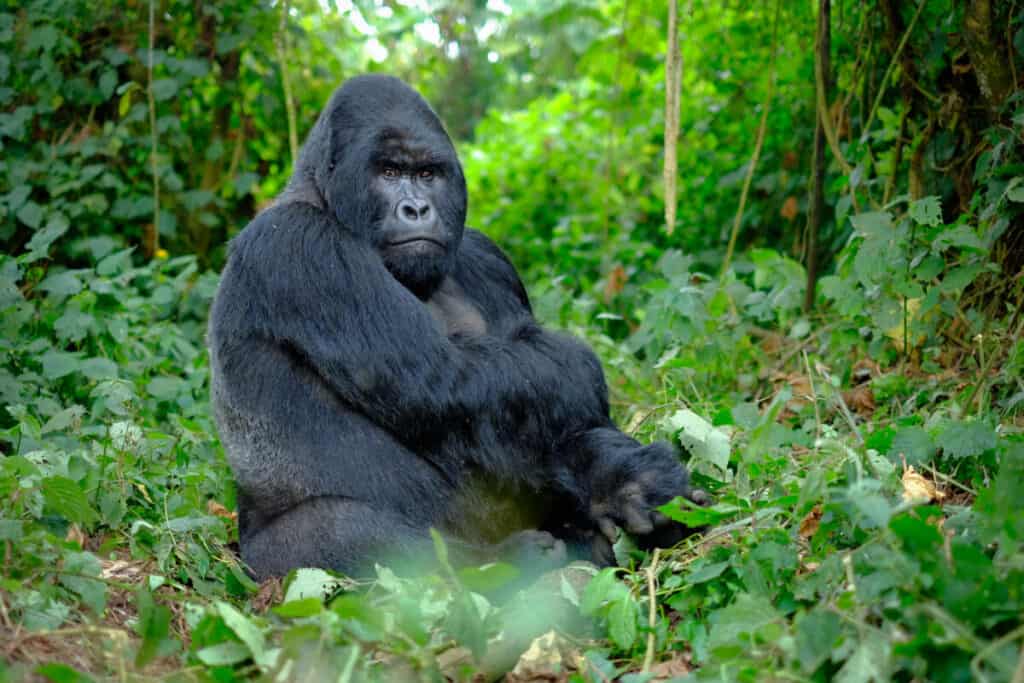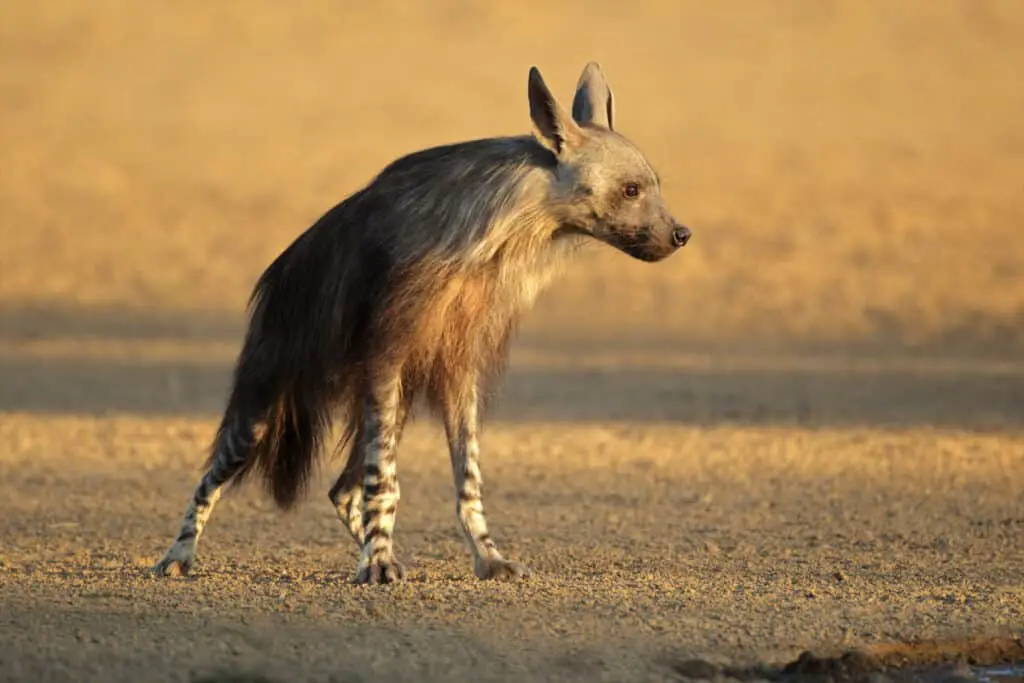Mountain gorillas are one of the most iconic and endangered species on Earth. They are exclusively found in the dense forests of central Africa, where their populations have been declining due to habitat loss, poaching, and disease. Despite being massive in size and strength, mountain gorillas face several threats from natural predators and human activities. Understanding these threats is crucial for conservation efforts aimed at protecting this majestic species.
This article will explore the various predators that pose a threat to mountain gorillas, including leopard. Additionally, we will examine how humans contribute to the decline of mountain gorilla populations through hunting, habitat destruction, and disease transmission. Finally, we will discuss conservation efforts aimed at preserving these critically endangered primates and their habitats.

The Vulnerability of Young Mountain Gorillas
The susceptibility of juvenile mountain gorillas to predation by leopards and other large carnivores is a significant concern for conservationists working to protect the species. Young mountain gorillas are particularly vulnerable due to their small size, lack of experience, and dependence on their mothers and group members for protection. Social behavior plays an important role in the survival of young mountain gorillas as they learn from older individuals in their group about what foods are safe to eat, how to avoid danger, and how to interact with others.
Parental care is also a critical factor influencing the survival of young mountain gorillas. Mothers provide constant attention and protection for their offspring, carrying them on their backs until they are strong enough to move independently. However, habitat loss and fragmentation pose significant challenges for gorilla conservation efforts. As humans continue to encroach on mountain gorilla habitats, the risk of human-wildlife conflict increases, threatening both adult and juvenile individuals. In addition, fragmented habitats make it more difficult for groups of gorillas to find sufficient food resources and maintain social connections within their communities.
Natural Predators of Mountain Gorillas
Mountain gorillas are apex predators and the only threat are leopards which can prey on both young and adult gorillas. These attacks are rare, as the strength of a mountain gorilla can overpower a leopard easily. Due to the social structure of mountain gorillas, they are often able to protect themselves from such predators through group defense mechanisms.
Another factor that plays a role in protecting mountain gorillas from predators is their specialized diet. Gorillas consume large quantities of vegetation each day, which means they rarely have to leave the safety of their forested habitats in search of food elsewhere. This reduces their exposure to potential dangers outside their home ranges.
Additionally, as herbivores, they do not pose a direct threat to other animals and therefore do not attract predatory attention towards themselves. Overall, while there are certainly risks associated with living in the wild for any animal species, mountain gorillas have adapted well to their environment and remain relatively safe from natural predators.
Leopards
Leopards pose a significant danger to juvenile members of the gorilla community, and their ability to prey on these young animals puts them at risk of population decline. Leopards are known to be opportunistic predators that prey on various animals, including mountain gorillas. They are equipped with sharp claws and teeth that allow them to take down even larger prey.
Gorilla parenting plays a crucial role in protecting young gorillas from leopard attacks. Adult gorillas will often form protective circles around juveniles when they sense danger, vocalizing loudly and beating their chests as a warning signal to potential predators. Additionally, adult gorillas will fiercely defend their offspring against any perceived threat, including leopards. However, despite the best efforts of adult gorillas, leopard attacks still occur and can have devastating consequences for the survival of young mountain gorillas.
Hyenas: Opportunistic Hunters of Gorilla Groups
Hyenas are known to take advantage of vulnerable moments in gorilla group dynamics to hunt and scavenge for food. While mountain gorillas are generally considered a keystone species, they are not immune to predation. In fact, hyenas have been observed preying on both adult and young gorillas. These interactions are rare, however.
Hyena behavior is opportunistic and they will target any animal that presents an opportunity for a meal. However, it’s important to note that while hyenas may pose a threat to some individuals within a gorilla group, gorillas also have defense mechanisms that help protect them from predators.
For example, when confronted by a potential predator such as a hyena, gorillas have been observed engaging in aggressive displays and vocalizations as well as forming defensive circles around vulnerable members of the group. Additionally, mountain gorillas often seek refuge in dense vegetation or trees when threatened by predators. Overall, while hyenas may be a threat to mountain gorillas at times, these primates possess unique strategies for survival in the face of danger.
| Gorilla Defense Mechanisms | Hyena Behavior |
|---|---|
| Aggressive Displays/Vocalizations | Opportunistic Hunter |
| Defensive Circles Around Vulnerable Members | Scavenger |
| Seek Refuge In Dense Vegetation/Trees When Threatened | Will Target Any Animal That Presents An Opportunity For A Meal |

Humans: The Greatest Threat to Mountain Gorillas
The survival of the critically endangered population of gorillas is threatened primarily by human activities such as poaching, habitat destruction, and disease transmission. The impact of tourism on gorilla populations cannot be ignored either. Although it provides economic benefits to the local communities and conservation organizations, unregulated tourism can have negative impacts on gorilla habitats and their behavior. Human-wildlife conflicts also arise when people encroach upon gorilla habitat for agricultural or settlement purposes, leading to conflicts with mountain gorillas.
Moreover, illegal hunting for bushmeat has been a major cause of death among mountain gorillas. Gorillas are often caught in snares laid out for other wildlife species by hunters who operate illegally within protected areas. Although hunting for bushmeat has declined significantly over the years due to conservation efforts, it remains a significant threat to the survival of these great apes. In addition to this, diseases transmitted from humans or domestic animals pose a serious threat to mountain gorillas as they are highly susceptible to respiratory infections like pneumonia and flu. Therefore, effective management strategies that consider community needs and interests are necessary to address human activities that threaten the survival of mountain gorillas in their natural habitats.
Conservation Efforts to Protect Mountain Gorillas
Conservation organizations have implemented various strategies to protect the critically endangered population of gorillas from human activities. One approach is through ecotourism, which provides economic benefits to local communities living near gorilla habitats. This incentivizes them to participate in conservation efforts and reduce their reliance on illegal activities such as poaching and deforestation. By promoting sustainable tourism practices, these organizations also educate tourists on responsible behavior that minimizes disturbance to the gorillas’ natural habitat.
Another important strategy is community engagement, where conservationists work closely with local communities to provide education and training on wildlife conservation and sustainable livelihoods. This helps promote a sense of ownership of the gorillas’ habitat among community members, who become more interested in protecting it from harm. In addition, conservation groups collaborate with governments and other stakeholders to establish protected areas for the mountain gorillas. These areas are monitored regularly for illegal activities and encroachment by humans or livestock. Through these efforts, we can hope to preserve this species for future generations while improving the well-being of local communities living near gorilla habitats.
The Future of Mountain Gorilla Populations
Sustained efforts to improve the habitat of mountain gorillas and reduce human activities in their range may help ensure the continued survival of this critically endangered species. Ecotourism benefits have played a significant role in increasing awareness about the importance of protecting these animals, while also providing economic benefits for local communities. In countries like Rwanda, Uganda, and Congo, ecotourism has become a major source of revenue for conservation efforts. Tourists pay fees to visit gorilla habitats, which are then invested in funding anti-poaching patrols and other initiatives aimed at protecting these animals.
Poaching prevention methods have also been implemented as part of conservation efforts to protect mountain gorillas. These methods include hiring more park rangers to patrol protected areas, engaging with local communities to raise awareness about the negative impacts of poaching on both wildlife and human health, and increasing penalties for those caught engaging in illegal hunting activities. These measures have helped reduce poaching incidents over the years, but more needs to be done to completely eliminate this threat. Continued efforts are needed from governments, NGOs, and local communities to ensure that mountain gorillas can thrive in their natural habitats for generations to come.
Conclusion
In conclusion, mountain gorillas face various threats from natural predators, such as leopards and hyenas. However, humans pose the greatest danger to their survival due to poaching and habitat destruction. Conservation efforts have been put in place to protect these endangered primates, including establishing national parks and reserves where they can thrive without human interference. Additionally, initiatives such as ecotourism have helped increase public awareness of the importance of protecting mountain gorillas.
While there is still much work to be done in ensuring the long-term survival of mountain gorilla populations, there is hope for their future. The efforts of conservation organizations and governments have led to an increase in the number of wild gorillas in recent years. With continued dedication and support for these initiatives, we can ensure that these magnificent creatures continue to thrive in their natural habitats for generations to come.
